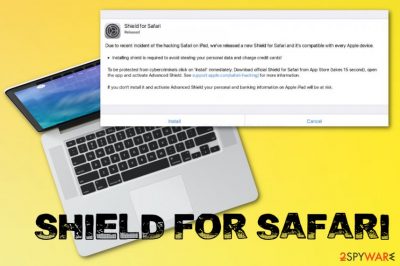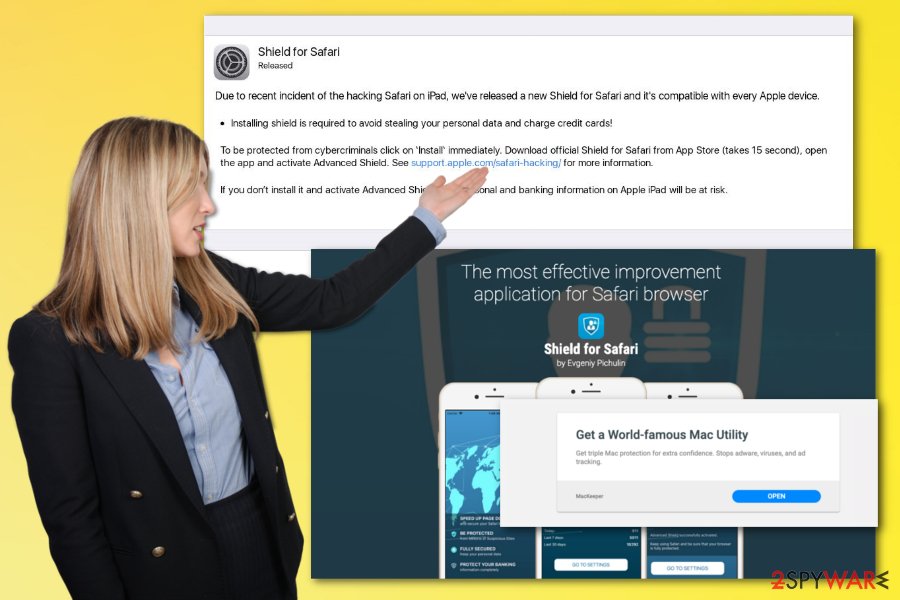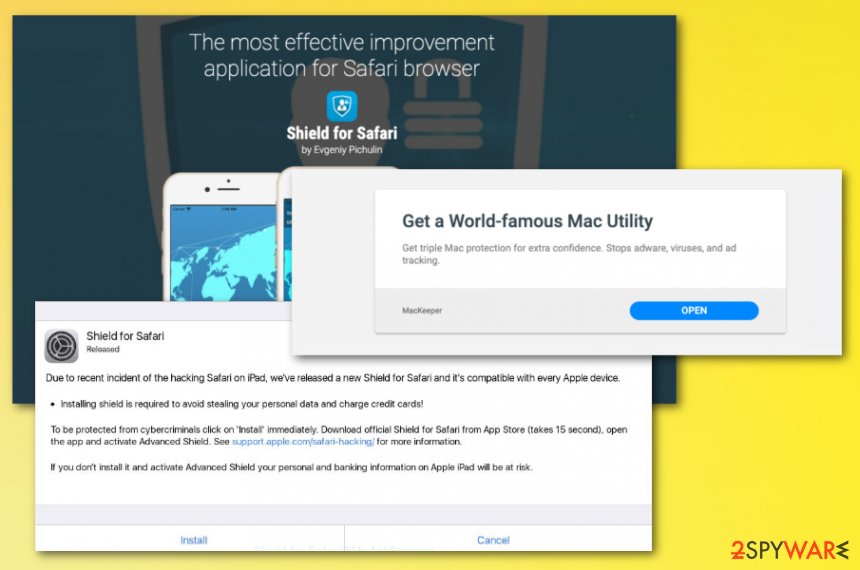Shield for Safari (Virus Removal Guide) - Free Instructions
Shield for Safari Removal Guide
What is Shield for Safari?
Shield for Safari is the application name appearing on suspicious pop-ups as a suggestion to update the safety of your Safari browser

Since there is no particular Shield for Safari application on the system when the pop-up appears, the update itself raises questions.[1] Fortunately, if you exit the window and don't activate any updates or downloads, you can safely browse online and use the machine further. Any interaction with the pop-up leads to more ad-supported sites where PUPs can get distributed, in a result, your machine more affected by cyber intruders. You should avoid such suspicious content and exit any shady pop-up, especially when software, updates, and other content is promoted. You can exit the window and avoid the infection, but an additional system check should ensure that there is no PUP running in the background.
| Name | Shield for Safari |
|---|---|
| Type | Mac malware/ Scam |
| Symptoms | Fake banners on various sites and pop-up messages appear pushing updates of the questionable application or Safari browser. Third-party programs get installed out of nowhere, and user encounters more messages from alleged technical support team members that suggest contacting people from Apple |
| Danger | Contact held between scammers and the PC user can lead to loss of data or money when the person on the other side requires payment for the provided help. Also, various commercial content that appears on the system can lead to malicious sites and malware infections, or exposed personal information, and data tracking issues[2] |
| Distribution | Such adware-type intruders get distributed with the help of other PUPs, deceptive pages, and shady promotional pop-ups shown on those websites. By clicking on various online material that is not safe you can trigger downloads of potentially dangerous applications |
| Tactics | Social engineering and technical support scam techniques get employed in this campaign where shady Safari and OS updates get promoted |
| Removal | To remove Shield for Safari from the machine, get anti-malware tool compatible with your device |
| Additional tip | You should also tackle the damage this suspicious program can cause, so FortectIntego or a similar repair program might offer the performance improving function |
Shield for Safari is probably developed by scammers who aim to get users' information, gain profit from them by redirecting or even directly claiming the payment for questionable technical help. You may receive the pop-up while browsing a common site on your Google Chrome, Safari, Mozilla Firefox, or another browser. It is even more suspicious and bizarre when the pop-up on Chrome suggests installing anything for your Safari, but pop-up can promote updates for your Mac OS directly. Unfortunately, people still fall for this scam.
Shield for Safari can be categorized as an adware or ad-supported program because the initial purpose of these pop-ups, banners, and redirects is to reroute the online traffic to malicious pages or sites where ad-tracking is the main goal and functionality.
Shield for Safari advertisements show up intrusively and cause other redirects so you cannot exit the initial page and keep visiting associated sites. Unfortunately, there is more to this technique because ad-supported sites include tracking technologies, and each page visit not only generates revenue for the publisher but also reveals details about users browsing habits and preferences.
You need to consider this feature as dangerous and try to remove Shield for Safari to end all the annoying symptoms of the adware. However, since the particular application cannot be located, you need to scan the system fully with a compatible anti-malware program that checks various places of your computer and indicates all the possible issues. 
Since application related to the intrusive adware activity may be hidden, the process of Shield for Safari removal becomes more difficult and requires employing professional anti-malware tools for help. You can find a program compatible with macOS that is capable of scanning the system fully to indicate malicious apps.
However, many places of the machine itself, settings, and programs or functions may still be affected by Shield for the Safari virus. For that reason, various experts[3] recommend getting a system tool, repair on cleaning utility like FortectIntego that may find and fix all the issues for you without any further damage.
Don't get surprised when your web browsers get changed or questionable content appears installed out of nowhere. Once adware like Shield for Safari lands on the machine, it can affect your browsing by setting the homepage or search engine to a suspicious site, installing in-browser tools, extensions. This is why we have a more in-depth guide below for browser resetting for you down below. 
Various sorts of software installations disguise shady utilities
Programs that flood your browser with numerous advertisements and content generating redirects to additional pages come from the internet because various deceptive websites deliver software on the machine that is not useful in any shape or form. – PUPs. System cleaning programs get promoted online with all the alleged claims, while in reality, such programs waste your time and sometimes money.
Various pop-ups with interactive buttons that suggest to unlock or allow content also trigger automated downloads of such adware and hijacker applications. The sole objective of these apps is to display more advertising content that reroutes you to scammy pages.
If you install anything from the internet or such alert about the download required appears on the screen, you need to take the advantage in your hands and choose Custom or Advanced options of the installation to check all the files and programs prepared to get launched on the machine. This way, you control what apps get to be installed and which ones get deleted entirely.
Get rid of shady applications and make sure to eliminate Shield for Safari fully to avoid infections
There is no need to call this application and adware campaign a Shield for Safari virus because there is no damage to the system this PUP could cause. However, there is nothing that should keep you from deleting the program from the machine entirely.
You need to remove Shield for Safari not by exiting the pop-up with an update notifications but by employing a professional anti-malware tool compatible with macOS devices. You need such software for a proper system scan because PUPs are silent intruders and can be set to install core files in multiple folders.
When this is done, you need to remove all files associated with the PUP to end the annoying redirects and fake alert pop-ups. So get anti-malware tools and perform a quick Shield for Safari removal automatically when the AV program indicates possible intruders for you. Additionally, go through our tips below to ensure that the machine is running normally.
You may remove virus damage with a help of FortectIntego. SpyHunter 5Combo Cleaner and Malwarebytes are recommended to detect potentially unwanted programs and viruses with all their files and registry entries that are related to them.
Getting rid of Shield for Safari. Follow these steps
Delete from macOS
Run through important parts of the OS to get rid of the Shield for Safari or follow these steps:
Remove items from Applications folder:
- From the menu bar, select Go > Applications.
- In the Applications folder, look for all related entries.
- Click on the app and drag it to Trash (or right-click and pick Move to Trash)

To fully remove an unwanted app, you need to access Application Support, LaunchAgents, and LaunchDaemons folders and delete relevant files:
- Select Go > Go to Folder.
- Enter /Library/Application Support and click Go or press Enter.
- In the Application Support folder, look for any dubious entries and then delete them.
- Now enter /Library/LaunchAgents and /Library/LaunchDaemons folders the same way and terminate all the related .plist files.

Remove from Mozilla Firefox (FF)
Remove dangerous extensions:
- Open Mozilla Firefox browser and click on the Menu (three horizontal lines at the top-right of the window).
- Select Add-ons.
- In here, select unwanted plugin and click Remove.

Reset the homepage:
- Click three horizontal lines at the top right corner to open the menu.
- Choose Options.
- Under Home options, enter your preferred site that will open every time you newly open the Mozilla Firefox.
Clear cookies and site data:
- Click Menu and pick Settings.
- Go to Privacy & Security section.
- Scroll down to locate Cookies and Site Data.
- Click on Clear Data…
- Select Cookies and Site Data, as well as Cached Web Content and press Clear.

Reset Mozilla Firefox
If clearing the browser as explained above did not help, reset Mozilla Firefox:
- Open Mozilla Firefox browser and click the Menu.
- Go to Help and then choose Troubleshooting Information.

- Under Give Firefox a tune up section, click on Refresh Firefox…
- Once the pop-up shows up, confirm the action by pressing on Refresh Firefox.

Remove from Google Chrome
Delete malicious extensions from Google Chrome:
- Open Google Chrome, click on the Menu (three vertical dots at the top-right corner) and select More tools > Extensions.
- In the newly opened window, you will see all the installed extensions. Uninstall all the suspicious plugins that might be related to the unwanted program by clicking Remove.

Clear cache and web data from Chrome:
- Click on Menu and pick Settings.
- Under Privacy and security, select Clear browsing data.
- Select Browsing history, Cookies and other site data, as well as Cached images and files.
- Click Clear data.

Change your homepage:
- Click menu and choose Settings.
- Look for a suspicious site in the On startup section.
- Click on Open a specific or set of pages and click on three dots to find the Remove option.
Reset Google Chrome:
If the previous methods did not help you, reset Google Chrome to eliminate all the unwanted components:
- Click on Menu and select Settings.
- In the Settings, scroll down and click Advanced.
- Scroll down and locate Reset and clean up section.
- Now click Restore settings to their original defaults.
- Confirm with Reset settings.

Delete from Safari
You should check the browser for any suspicious material and apps installed without your permission or knowledge
Remove unwanted extensions from Safari:
- Click Safari > Preferences…
- In the new window, pick Extensions.
- Select the unwanted extension and select Uninstall.

Clear cookies and other website data from Safari:
- Click Safari > Clear History…
- From the drop-down menu under Clear, pick all history.
- Confirm with Clear History.

Reset Safari if the above-mentioned steps did not help you:
- Click Safari > Preferences…
- Go to Advanced tab.
- Tick the Show Develop menu in menu bar.
- From the menu bar, click Develop, and then select Empty Caches.

After uninstalling this potentially unwanted program (PUP) and fixing each of your web browsers, we recommend you to scan your PC system with a reputable anti-spyware. This will help you to get rid of Shield for Safari registry traces and will also identify related parasites or possible malware infections on your computer. For that you can use our top-rated malware remover: FortectIntego, SpyHunter 5Combo Cleaner or Malwarebytes.
How to prevent from getting mac viruses
Access your website securely from any location
When you work on the domain, site, blog, or different project that requires constant management, content creation, or coding, you may need to connect to the server and content management service more often. The best solution for creating a tighter network could be a dedicated/fixed IP address.
If you make your IP address static and set to your device, you can connect to the CMS from any location and do not create any additional issues for the server or network manager that needs to monitor connections and activities. VPN software providers like Private Internet Access can help you with such settings and offer the option to control the online reputation and manage projects easily from any part of the world.
Recover files after data-affecting malware attacks
While much of the data can be accidentally deleted due to various reasons, malware is one of the main culprits that can cause loss of pictures, documents, videos, and other important files. More serious malware infections lead to significant data loss when your documents, system files, and images get encrypted. In particular, ransomware is is a type of malware that focuses on such functions, so your files become useless without an ability to access them.
Even though there is little to no possibility to recover after file-locking threats, some applications have features for data recovery in the system. In some cases, Data Recovery Pro can also help to recover at least some portion of your data after data-locking virus infection or general cyber infection.
- ^ Just received a “Shield for Safari” update. Is this a valid update?. Discussions. Apple community forum.
- ^ barbara Krasnoff. Ad tracking on Iphone. Theverge. Technology and media news network.
- ^ Virusai. Virusai. Spyware related news.












